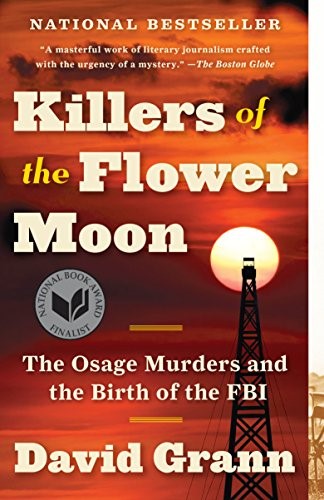Killers of the Flower Moon: The Osage Murders and the Birth of the FBI

from amazon.com
In the 1920s, the richest people per capita in the world were members of the Osage Indian nation in Oklahoma. After oil was discovered beneath their land, they rode in chauffeured automobiles, built mansions, and sent their children to study in Europe.
Then, one by one, the Osage began to be killed off. The family of an Osage woman, Mollie Burkhart, became a prime target. Her relatives were shot and poisoned. And it was just the beginning, as more and more members of the tribe began to die under mysterious circumstances.
In this last remnant of the Wild West—where oilmen like J. P. Getty made their fortunes and where desperadoes like Al Spencer, the “Phantom Terror,” roamed—many of those who dared to investigate the killings were themselves murdered. As the death toll climbed to more than twenty-four, the FBI took up the case. It was one of the organization’s first major homicide investigations and the bureau badly bungled the case. In desperation, the young director, J. Edgar Hoover, turned to a former Texas Ranger named Tom White to unravel the mystery. White put together an undercover team, including one of the only American Indian agents in the bureau. The agents infiltrated the region, struggling to adopt the latest techniques of detection. Together with the Osage they began to expose one of the most chilling conspiracies in American history.
In Killers of the Flower Moon, David Grann revisits a shocking series of crimes in which dozens of people were murdered in cold blood. Based on years of research and startling new evidence, the book is a masterpiece of narrative nonfiction, as each step in the investigation reveals a series of sinister secrets and reversals. But more than that, it is a searing indictment of the callousness and prejudice toward American Indians that allowed the murderers to operate with impunity for so long. Killers of the Flower Moon is utterly compelling, but also emotionally devastating.
https://www.amazon.com/Killers-Flower-Moon-Osage-Murders-ebook/dp/B01CWZFBZ4
Author: David Grann

David Grann is a #1 New York Times bestselling author and an award-winning staff writer at The New Yorker magazine. Before joining The New Yorker in 2003, Grann was a senior editor at The New Republic, and, from 1995 until 1996, the executive editor of the newspaper The Hill. He holds master’s degrees in international relations from the Fletcher School of Law & Diplomacy as well as in creative writing from Boston University. After graduating from Connecticut College in 1989, he received a Thomas Watson Fellowship and did research in Mexico, where he began his career in journalism. He currently lives in New York with his wife and two children.
Reviewed by: John Stokdijk

Killers of the Flower Moon: The Osage Murders and the Birth of the FBI by David Grann is a murder mystery. But it is much more than that. It is also a chronicle of a journey from rags to riches to rags. It is about one of the last frontiers of the wild west. It is about the early days of the Federal Bureau of Investigation and the rise of J. Edgar Hoover. And it is a shocking narrative of good and evil.
Killers of the Flower Moon is not only a good story but it is also skillfully written. This book is a page-turner, more commonly true of works of fiction. Once I started reading I was hooked and it did not take me long to go from start to finish.
The story begins in 1921 with the disappearance of a thirty-four year old Indian woman, Anna Brown, on Osage territory in Oklahoma. I had never heard of this Indian tribe and I knew nothing about how they came to be extremely wealthy because of the discovery of oil. Three things conspired to later destroy that wealth - theft, the Great Depression and the depletion of oil wells.
It was shocking to read about the widespread corruption in Oklahoma less than a hundred years ago. There were many murders and little justice. There was greed, unbelievable greed.
A particularly disgusting kind of corruption is that which is legal but grossly immoral.And few places in the country were as chaotic as Osage County, where the unwritten codes of the West, the traditions that bound communities, had unraveled. By one account, the amount of oil money had surpassed the total value of all the Old West gold rushes combined, and this fortune had drawn every breed of miscreant from across the country.
The U.S. government, contending that many Osage were unable to handle their money, had required the Office of Indian Affairs to determine which members of the tribe it considered capable of managing their trust funds. Over the tribe’s vehement objections, many Osage, including Lizzie and Anna, were deemed “incompetent,” and were forced to have a local white guardian overseeing and authorizing all of their spending, down to the toothpaste they purchased at the corner store. One Osage who had served in World War I complained, “I fought in France for this country, and yet I am not allowed even to sign my own checks.” The guardians were usually drawn from the ranks of the most prominent white citizens in Osage County.
A four year period in the 1920s became known as the Reign of Terror. The evil of such times often results from the harm of valuing some humans, in this case American Indians, far less than other humans, in this case white humans. The trauma from a hundred years ago still lingers today.
Evil people deserve to be named and in this story they are William Hale and Ernest Burkhart. Good people deserve to be recognized and in this story they are Tom White and David Grann. More difficult to categorize is J. Edgar Hoover.
...a series of sensational crimes in the 1930s stoked public fears and enabled Hoover to turn the organization into the powerful force recognized today… Hoover ensured that the identity of the bureau was indistinguishable from his own… The many details of Hoover’s abuses of power would not be made public until after his death, in 1972...
The story seems to come to a close after the first two sections which describe the murders and the FBI investigations. I had noticed that the book had three sections and I wondered what the last one would be about. It turned out to be fascinating, describing the contribution of David Grann himself to the story.
Like most Americans, when I was in school, I never read about the murders in any books; it was as if these crimes had been excised from history. So when I stumbled upon a reference to the murders, I began to look into them. Since then, I had been consumed with trying to resolve lingering questions, to fill in the gaps in the FBI’s investigation.
David Grann is a journalist. He had stumbled upon the Osage murders and in 2012 he decided to investigate further. He uncovered a story even bigger and even darker than the official version. His book captures some history which otherwise might have been completely lost forever. I am grateful for his efforts and I greatly appreciate his book. I can only wonder about similar stories yet to be found and shared.
